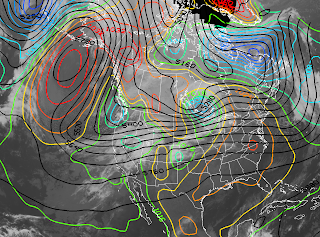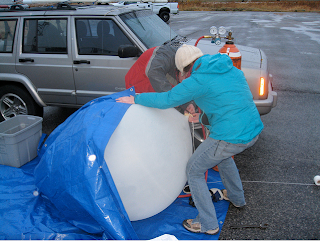Whatever happened to the Greatest Snow on Earth? The
UAC is reporting that 10 inches of heavy dense graupel fell last night in LCC, with a water content of 20%! There were numerous reports of riming and drizzle in the Cottonwoods yesterday as well. Green light conditions are over in the backcountry.
To understand the 24 hours, we need to recognize that liquid water needs a "partner", known as an ice nuclei, to turn into ice, even at temperatures below freezing. Liquid water's preferred partner is ice, and if it comes in contact with ice, it will gladly freeze if the temperature is below 0C. On the otherhand, liquid water is more selective with other potential ice nuclei. If the water comes in contact with a particle that has a molecular structure similar to ice, it may freeze at relatively warm temperatures that are only a few degrees below freezing. On the otherhand, if the water comes in contact with a particle that is dissimilar to ice, it may not freeze until temperatures are well below freezing, perhaps -15 C or colder. There are not alot of ice nuclei floating around, so it can be hard to get a cloud to glaciate, especially if cloud top temperatures are not well below freezing.
During yesterdays riming event, we were dealing with a very stable cloud deck, with a base near 750 mb where the temperature was around -6C and a top near 675 mb where the temperature was -8C.
Under such a scenario, it is very hard to get water droplets to freeze because there are not alot of ice nuclei. As a result, you get alot of riming as cloud droplets freeze on contact with the ground, trees, your goggles, etc., and you get drizzle as the droplets grow through collision and coalescence. Sure there can be some snow, but you are dealing with a really messy mixed regime.
Major changes occurred, however, with the precipitation dynamics overnight as temperatures cooled aloft and the moisture deepened. By 12Z this morning, cloud top extended to 500 mb, where temperatures were below -20C, and lapse rates were moist-neutral through a deep layer.
In this scenario, getting particles to freeze and snowflakes to form in the upper-portions of the cloud is not so challenging. BUT, we have tons of supercooled water to play with near cloud base where temperatures are very near 0C. Given the near-neutral conditions, graupel is forming as these supercooled droplets freeze on contact with falling ice particles in the cloud. This is riming too, but it is leading to hydrometeor growth within the cloud.
These processes are very common in maritime climates such as the Cascades and Sierra Nevada, but less common here where are storms are typically colder, have more ice nuclei, and have less supercooled liquid water. For now, however, we are dealing with an environment that is more maritime than continental, so we get to enjoy Cascadian snow for a while. In my view, it's all good when you need base.




















































